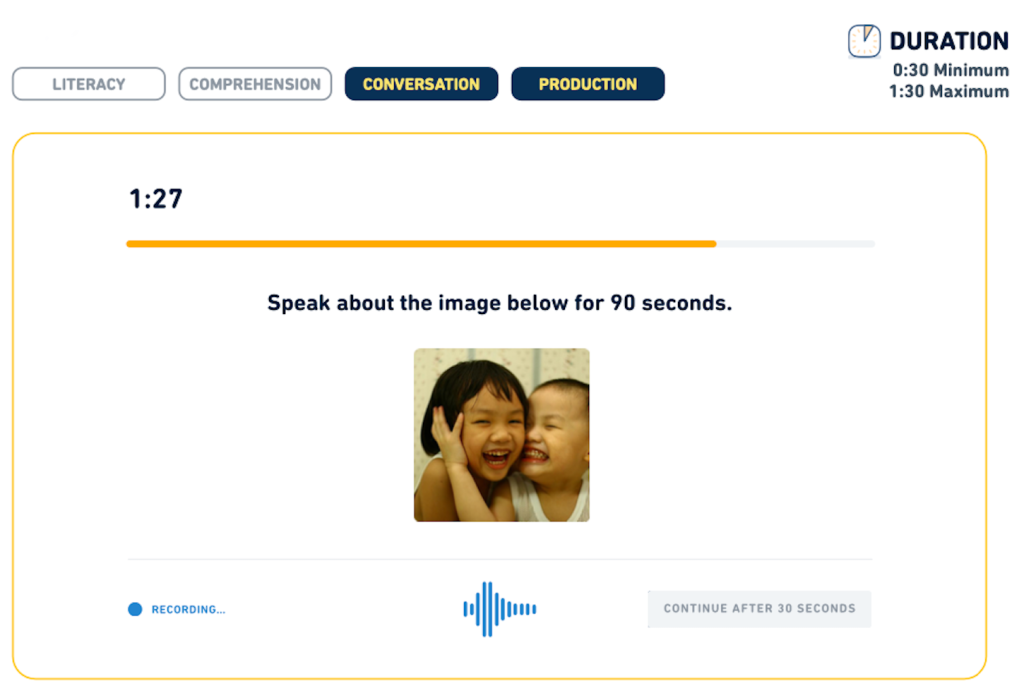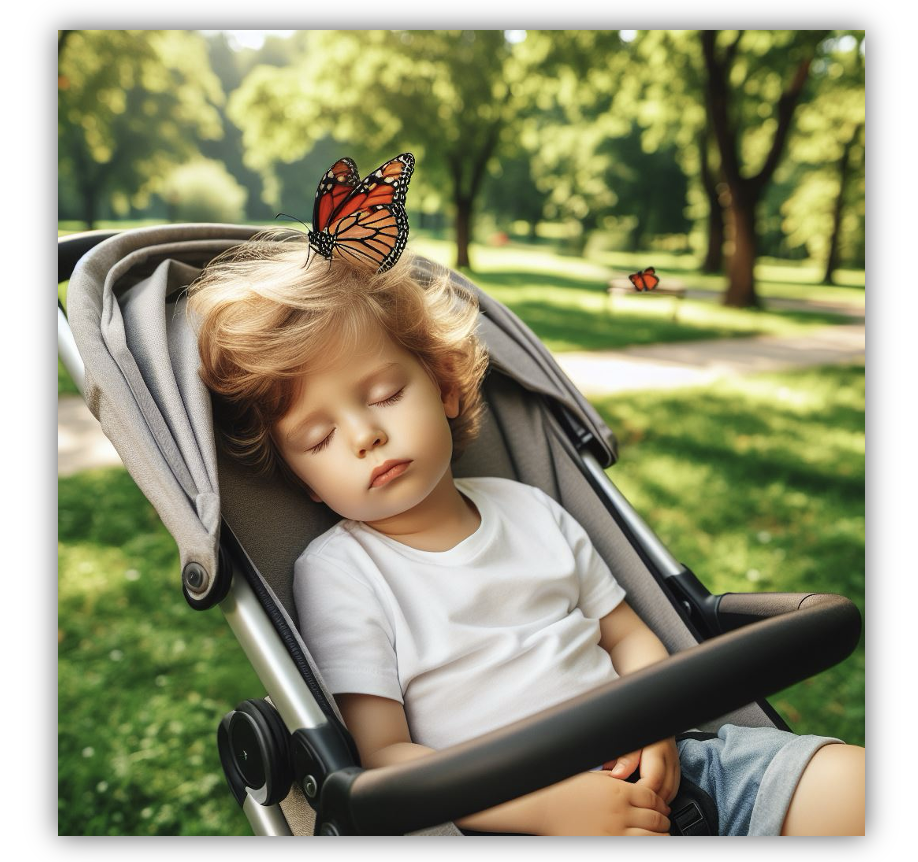Las mejores técnicas para la prueba de habla de Duolingo: Dominar la tarea 'Hablar sobre la foto'
¡Hola, futuros campeones del DET (Duolingo English Test)! Bienvenidos a DET Practice. Hoy exploraremos cómo abordar la sección de ‘Speak about the Photo’ en el DET. Primero, echemos un vistazo a lo que es la pregunta de ‘Speak about the Photo’:

Esta sección, como aparece en la guía de estudio oficial del DET, implica un ejercicio oral único. A diferencia de las tareas de habla en TOEFL o IELTS, esta tarea requiere que describas una fotografía verbalmente en inglés. Impacta tanto las puntuaciones de ‘Conversación’ como las de ‘Producción’, con un tiempo de respuesta de 30-90 segundos.
* Para una introducción más detallada sobre la tarea de ‘Speak about the Photo’, recomendamos nuestro artículo anterior: “Speak about the Photo“.
Para entender la puntuación del DET y las estrategias para mejorarla, consulta “Duolingo English Test Scores: Insights and Comparisons” y “The Ultimate Guide to the Duolingo English Test” respectivamente.
Lograr una buena puntuación en las tareas orales requiere mantener la fluidez dentro del tiempo asignado. Esto también es crucial en otras pruebas de idioma como TOEFL o IELTS. Un desafío en ‘Speak about the Photo’ es la falta de indicaciones predefinidas, lo que puede dificultar mantener una respuesta de 1 minuto y 30 segundos, especialmente cuando los elementos de la foto son limitados. Entonces, ¿qué estrategias podemos emplear?
Estrategia para ‘Speak about the Photo’
Antes de adentrarnos en técnicas específicas, consideremos una foto de ejemplo. Ten en cuenta que el DET a menudo usa imágenes que presentan personas, que pueden incluir primeros planos de expresiones o acciones.

Descripción Objetiva
En el DET, las tareas orales se califican según la relevancia al tema. Recomendamos comenzar con una descripción objetiva de la foto dentro de los primeros 30 segundos para asegurar que tu respuesta esté centrada en el tema. Por ejemplo, si la foto muestra a un niño rubio durmiendo en un cochecito en un entorno al aire libre con frondosa vegetación, posiblemente un bosque o parque, podrías describir la vestimenta del niño (una camiseta blanca y pantalones cortos grises que sugieren una tarde cálida de verano) y una mariposa posada en su cabeza. También podrías transmitir la atmósfera pacífica y especular que un padre capturó este momento sereno. En ‘Speak about the Photo’, considera hablar sobre personas, ropa, acciones, profesiones, identidades, estados emocionales, expresiones faciales y entornos circundantes.
Según nuestra discusión previa, tu respuesta podría ser así:
So, what we’re looking at here is really a picture-perfect scene taken outdoors. The greenery is vibrant—there’s grass, and trees all around, so I’m thinking this could be a beautiful park or maybe even a bit of forest area. Now, right in the heart of this natural setting, we’ve got this adorable blond child, just fast asleep in their stroller. They’re dressed in the simplest summer outfit, you know, a white T-shirt, grey shorts—totally what you’d wear on a sunny afternoon. And there’s this little surprise—a butterfly has landed right on their head! It’s one of those moments that’s just so peaceful, so serene, it’s got to be one of those memories that parents love to capture. It’s the kind of day that just feels like a gift, doesn’t it?
Sí, esta respuesta suena bien. Pero hay un problema, es demasiado corta. Esta respuesta puede no ser suficiente para mantener 1 minuto y 30 segundos de tiempo de habla.
Comentario Personal
¿Está bien agregar comentarios personales? Sí. Después de describir objetivamente la foto, los comentarios personales relacionados con el contenido son una estrategia viable. Pero ten cuidado con el número de oraciones (3-5 oraciones) para evitar desviarte del tema. Los comentarios personales ayudan a expandir la respuesta mientras se mantiene la relevancia.
Para el ejemplo anterior, podríamos agregar:
Well, looking at this image really warms my heart. It’s such a delightful scene. Being outdoors, taking in the fresh air, it’s incredibly beneficial for kids—both for their physical health and mental well-being. They get to be up close to nature, run around, jump, and even interact with wildlife, like this gentle butterfly here. It’s fantastic because it’s not just about staying active; it’s about feeding their curiosity as well. I truly believe that kids should engage in outdoor activities more often.
La respuesta se ve bien, agregamos nuestros propios comentarios e intentamos mantener la respuesta en el tema. Por lo tanto, recuerda, agregar comentarios personales es una buena manera de expandir la pregunta de ‘Speak about the Photo’. ¿Hay otras formas de expandir la respuesta? Por favor, sigue leyendo el contenido siguiente.
Foto del fondo
Considera el contexto de la foto. Podemos pensar en ello, bajo qué circunstancias se tomó una imagen. Como en nuestro ejemplo anterior, podemos imaginar. Esta imagen puede haber sido tomada por los padres del niño, esto puede ser un fin de semana (porque no tienen que trabajar, tienen tiempo para salir al aire libre o al parque para dar un paseo o relajarse), una escena de una salida familiar. ¿O en qué te recuerda esta imagen? Por ejemplo, tu propia experiencia de infancia. Tal vez podamos decir que esta imagen me recuerda mi infancia, mis padres y yo solíamos ir al parque cerca de nuestra casa, y el paisaje en el parque era tan hermoso como la imagen. Bueno, es hora de que sigamos ampliando la respuesta, continuemos con la respuesta anterior:
You know, this photo might very well have been taken by the child’s parents, capturing a slice of family time—perhaps over the weekend when there’s no work to rush to, allowing for a leisurely stroll in the outdoors or some relaxing time in the park. And it’s the kind of scene that nudges at my own memories, taking me back to my childhood. My parents would often take me to the park near our home, much like the one in this picture, where the scenery was just as picturesque.
Ahora la respuesta parece más sustancial.
Agregar Sentimientos Personales
¿Esto estará fuera de tema? No si tu operación es correcta. Esta es la parte donde realmente demuestras tus habilidades, porque estamos hablando de los sentimientos que la imagen nos trae, por ejemplo, podemos decir esto:
So, it’s more than just a photograph; it’s a reminder of those carefree, joyful days. It’s about the bond we share with our loved ones and the simple pleasures of life, like watching your child sleep peacefully under the watchful eye of nature. You know, this image is a beautiful echo of times spent with family, treasured and timeless.
Bueno, eso es todo. Creo que tenemos un ejemplo de respuesta oral bastante completo y de alto nivel, juntemos todo:
Well, looking at this image really warms my heart. It’s such a delightful scene. Being outdoors, taking in the fresh air, it’s incredibly beneficial for kids—both for their physical health and mental well-being. They get to be up close to nature, run around, jump, and even interact with wildlife, like this gentle butterfly here. It’s fantastic because it’s not just about staying active; it’s about feeding their curiosity as well. I truly believe that kids should engage in outdoor activities more often.
You know, this photo might very well have been taken by the child’s parents, capturing a slice of family time—perhaps over the weekend when there’s no work to rush to, allowing for a leisurely stroll in the outdoors or some relaxing time in the park. And it’s the kind of scene that nudges at my own memories, taking me back to my childhood. My parents would often take me to the park near our home, much like the one in this picture, where the scenery was just as picturesque.
So, it’s more than just a photograph; it’s a reminder of those carefree, joyful days. It’s about the bond we share with our loved ones and the simple pleasures of life, like watching your child sleep peacefully under the watchful eye of nature. You know, this image is a beautiful echo of times spent with family, treasured and timeless.
Al combinar estos enfoques, puedes crear una respuesta oral completa y bien desarrollada. Esperamos que estas estrategias te ayuden a sobresalir en la sección ‘Speak about the Photo’ del DET. ¡Buena suerte con tu Duolingo English Test!
Comienza a practicar hoy registrándote para nuestro banco de preguntas del DET de forma gratuita.






